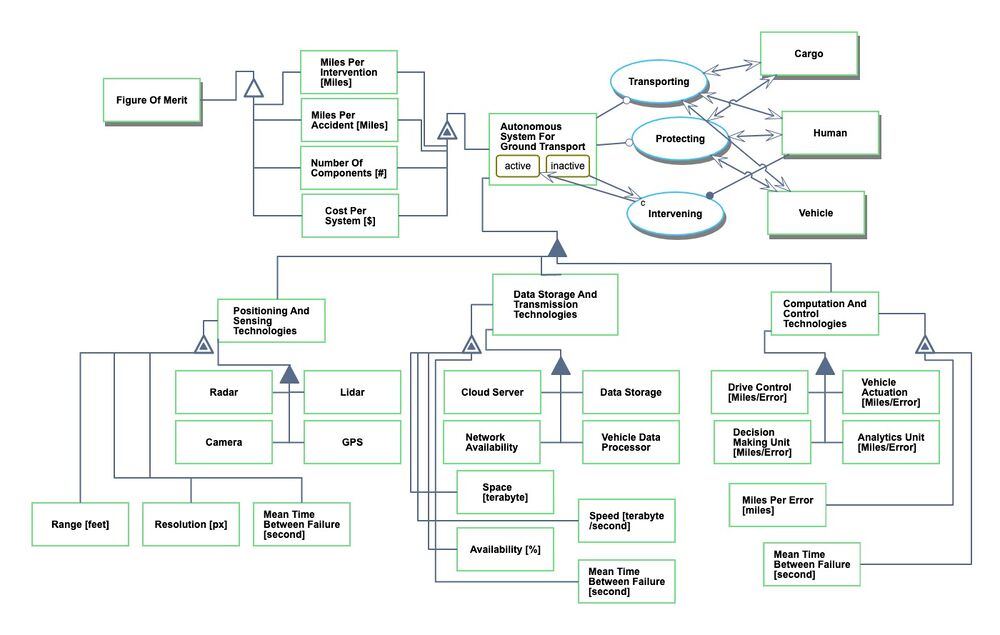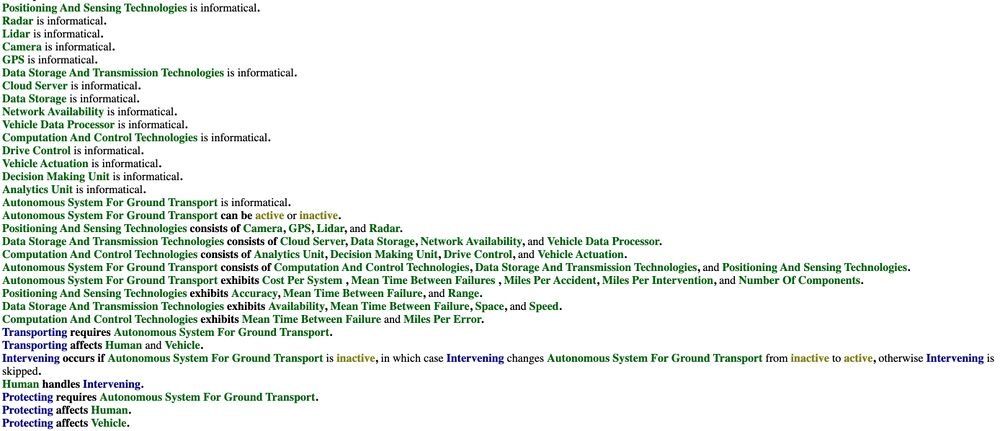Difference between revisions of "Autonomous System for Ground Transport"
| Line 15: | Line 15: | ||
We provide an Object-Process-Diagram (OPD) of the 2ASGT roadmap in the figure below. This diagram captures the main object of the roadmap (Autonomous System for Ground Transport), its 2-level decomposition into enabling systems (Positioning and Sensing Technologies, Data Storage and Transmission Technologies, Computation and Control Technologies), its characterization by Figures of Merit (FOMs) as well as the main processes and other objects it interacts with. | We provide an Object-Process-Diagram (OPD) of the 2ASGT roadmap in the figure below. This diagram captures the main object of the roadmap (Autonomous System for Ground Transport), its 2-level decomposition into enabling systems (Positioning and Sensing Technologies, Data Storage and Transmission Technologies, Computation and Control Technologies), its characterization by Figures of Merit (FOMs) as well as the main processes and other objects it interacts with. | ||
[[File:ASGTOPM.jpeg|1000 px]] | [[File:ASGTOPM.jpeg|1000 px]] | ||
An Object-Process-Language (OPL) description of the roadmap scope is auto-generated and given below. It reflects the same content as the previous figure, but in a formal natural language. | An Object-Process-Language (OPL) description of the roadmap scope is auto-generated and given below. It reflects the same content as the previous figure, but in a formal natural language. | ||
[[File:ASGTOPL.jpg|1000 px]] | [[File:ASGTOPL.jpg|1000 px]] | ||
Revision as of 18:30, 6 October 2019
Technology Roadmap Sections and Deliverables
The first point is that each technology roadmap should have a clear and unique identifier:
- 2ASGT - Autonomous System for Ground Transport
This indicates that we are dealing with a “level 2” roadmap at the product level, where “level 1” would indicate a market level roadmap and “level 3” or “level 4” would indicate an individual technology roadmap.
Roadmap Overview
Design Structure Matrix (DSM) Allocation
Roadmap Model using OPM
We provide an Object-Process-Diagram (OPD) of the 2ASGT roadmap in the figure below. This diagram captures the main object of the roadmap (Autonomous System for Ground Transport), its 2-level decomposition into enabling systems (Positioning and Sensing Technologies, Data Storage and Transmission Technologies, Computation and Control Technologies), its characterization by Figures of Merit (FOMs) as well as the main processes and other objects it interacts with.

An Object-Process-Language (OPL) description of the roadmap scope is auto-generated and given below. It reflects the same content as the previous figure, but in a formal natural language.

Figures of Merit
Alignment with Company Strategic Drivers
Positioning of Company vs. Competition
Technical Model
Financial Model
List of R&T Projects and Prototypes
Key Publications, Presentations and Patents
Technology Strategy Statement
A technology roadmap should conclude and be summarized by both a written statement that summarizes the technology strategy coming out of the roadmap as well as a graphic that shows the key R&D investments, targets and a vision for this technology (and associated product or service) over time. For the 2SEA roadmap the statement could read as follows:
Our target is to develop a new solar-powered and electrically-driven UAV as a HAPS service platform with an Entry-into-Service date of 2030. To achieve the target of an endurance of 500 days and useful payload of 10 kg we will invest in two R&D projects. The first is a flight demonstrator with a first flight by 2027 to demonstrate a full-year aloft (365 days) at an equatorial latitude with a payload of 10 kg. The second project is an accelerated development of Li-S batteries with our partner XYZ with a target lifetime performance of 500 charge-discharge cycles by 2027. This is an enabling technology to reach our 2030 technical and business targets.